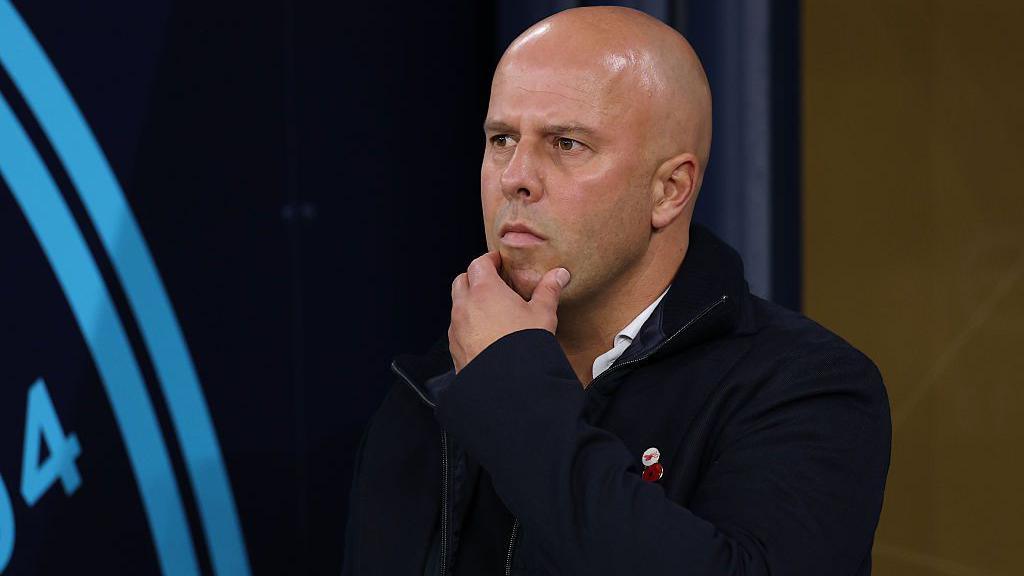Reigning Premier League champions Liverpool began the season well, but now find themselves in eighth place after 11 games.
Over the past six league games Liverpool have picked up just three points – with only bottom-of-the-league Wolves gaining fewer in this period.
And this is despite the Reds spending more than £400m – and bringing in superstar talent – in the summer.
Why Liverpool struggle to build out from back
Many of Liverpool’s problems this season stem from how they build from the back.
As a result of Trent Alexander-Arnold joining Real Madrid in the summer and goalkeeper Alisson Becker’s injury six weeks ago, Liverpool’s backline is playing differently.
Giorgi Mamardashvili has replaced the injured Alisson in goal and a subtle detail contributing to Liverpool’s form comes from the fact the keepers have different strong feet.
Mamardashvili is left-footed, which means he plays certain passes Alisson wouldn’t.

Keepers are able to play short passes more quickly when passing across their body. Opening up their body and playing to the far side generally takes longer.
For Alisson, this would funnel play towards Virgil van Dijk, the stronger ball-playing centre-back. Mamardashvili’s left foot ushers the ball more naturally to the right side now occupied by Ibrahima Konate and Conor Bradley or Jeremie Frimpong.
For the majority of this season, Liverpool have opted to build up short and have struggled to do so, particularly down their right.

When the ball does go to the right side of defence, Liverpool are less able to get out of pressurised situations without Alexander-Arnold.

A closer look at individual players highlights Milos Kerkez’s struggles in disguising his passing intentions at times from left-back. Bradley appears to play at a fast pace but slowing down play in the build-up can actually help teams disrupt an opponents’ press and establish safer possession.
Why Liverpool aren’t getting best out of Salah
Mohamed Salah was central to much of Liverpool’s success last season, so why has the Egyptian been less effective so far this campaign?
Liverpool’s right flank last season was impressive, often consisting of Salah, Dominik Szoboszlai and Alexander-Arnold.
Analysing the latter last season demonstrates how it wasn’t only his quality on the ball that stood out – his excellent off-the-ball movement also helped Salah shine.
Using the game against Bournemouth last season as an example, Alexander-Arnold would take a high, attacking midfield position centrally when Liverpool’s defenders had the ball. A Bournemouth central midfielder was now responsible for defending him and they would often have to drop deeper.
His positioning helped free up the passing lane from Konate to Salah, allowing the Egyptian to receive the ball with ease.

Another benefit to Alexander-Arnold’s inside position here is that rather than having two of the midfield three playing in attacking positions high up the pitch, he and Szoboszlai occupied these areas instead.
This allowed two natural central midfielders in Ryan Gravenberch and Alexis Mac Allister to be positioned behind the ball, centrally. Natural defensive midfielders playing behind the ball offer greater defensive solidity when starting in central areas, as this is where counter-attacks are most dangerous.
When compared to this season, the knock-on effects become clear.
Liverpool’s full-backs find themselves out wide in their own half, often unable to find their team-mates centrally. The passing lane from Konate to Salah can become crowded too.
Liverpool’s full-backs will at times play passes straight to Salah instead. Salah therefore receives passes with pressure from behind him, meaning he is unable to turn and attack dangerously. This reduces how effective he can be.
Liverpool’s biggest defensive problem this season
Liverpool pressed intensely for many years under Jurgen Klopp but under Slot their out-of-possession tactics differ.
Liverpool now tend to press in a 4-2-4 shape. A principle Slot likes to use is having an extra player in the defensive line compared to the number of attackers the opponents have. This can be described as having a ‘plus one’ at the back.
Opponents often have a striker and two wide players positioned high. Liverpool under Slot usually keep their four defenders back to have a one player advantage.

Pressing opponents that have an extra player in the build-up is a challenge that can be addressed through strong individual pressers.
Alternatively, the press can be executed in a way that allows one player to cover multiple opposition players, often by pressing one player while blocking the passing lane to another.
Generally, teams that press with fewer players up front are looking to force opponents into building down one side before cutting off access to the other side of the pitch.
Slot’s big defensive dilemma
In the win against Arsenal earlier this season, Liverpool started the match by keeping a ‘plus-one’ in their defensive line. This meant that in the build-up Arsenal regularly had a spare man.

Arsenal dominated the first half partly because of this overload and Slot opted for a man-to-man press in the second half to fix this.
Szoboszlai was then tasked with pressing Calafiori which helped Liverpool impose themselves and showcased Slot’s understanding of the issue.
It did, however, leave Liverpool man-for-man at the back, something Slot doesn’t like to do.
Form down to more than just tactics
This isn’t an exhaustive list of all of Liverpool’s problems this season but does highlight some of the main issues Slot and his coaching staff will have to contend with to get Liverpool back on track.
Liverpool’s struggles from set-pieces and in dealing with long balls, in a league that is increasingly prioritising both, have contributed to their poor results this season.
There is also the unavoidable fact that the tragic death of team-mate Diogo Jota will have played on the minds of Liverpool’s players and staff.
Related topics
- Liverpool
- Premier League
- Football
Source: BBC

Leave a Reply